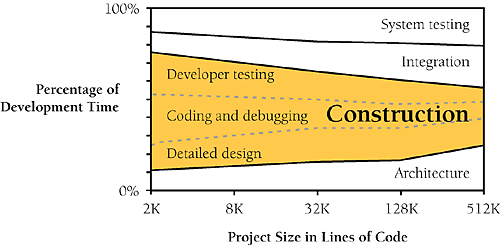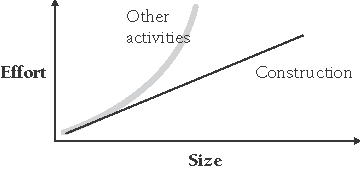27.5. Effect of Project Size on Development Activities
| < Free Open Study > |
| If you are working on a one-person project, the biggest influence on the project's success or failure is you. If you're working on a 25-person project, it's conceivable that you're still the biggest influence, but it's more likely that no one person will wear the medal for that distinction; your organization will be a stronger influence on the project's success or failure. Activity Proportions and SizeAs project size increases and the need for formal communications increases, the kinds of activities a project needs change dramatically. Figure 27-3 shows the proportions of development activities for projects of different sizes. Figure 27-3. Construction activities dominate small projects. Larger projects require more architecture, integration work, and system testing to succeed. Requirements work is not shown on this diagram because requirements effort is not as directly a function of program size as other activities are (Albrecht 1979; Glass 1982; Boehm, Gray, and Seewaldt 1984; Boddie 1987; Card 1987; McGarry, Waligora, and McDermott 1989; Brooks 1995; Jones 1998; Jones 2000; Boehm et al. 2000)
Construction becomes less predominant because as project size increases, the construction activities detailed design, coding, debugging, and unit testing scale up proportionately but many other activities scale up faster. Figure 27-4 provides an illustration. Figure 27-4. The amount of software construction work is a near-linear function of project size. Other kinds of work increase nonlinearly as project size increases
Projects that are close in size will perform similar activities, but as sizes diverge, the kinds of activities will diverge, too. As the introduction to this chapter described, when the Gigatron Deluxe comes out at 10 times the size of the original Gigatron, it will need 25 times more construction effort, 25 50 times the planning effort, 30 times the integration effort, and 40 times the architecture and system testing.
Here's a list of activities that grow at a more-than-linear rate as project size increases:
Regardless of the size of a project, a few techniques are always valuable: disciplined coding practices, design and code inspections by other developers, good tool support, and use of high-level languages. These techniques are valuable on small projects and invaluable on large projects. Programs, Products, Systems, and System ProductsLines of code and team size aren't the only influences on a project's size. A more subtle influence is the quality and the complexity of the final software. The original Gigatron, the Gigatron Jr., might have taken only a month to write and debug. It was a single program written, tested, and documented by a single person. If the 2,500-line Gigatron Jr. took one month, why did the full-fledged 25,000-line Gigatron take 20 months? Further Reading For another explanation of this point, see Chapter 1 in The Mythical Man-Month (Brooks 1995). The simplest kind of software is a single "program" that's used by itself by the person who developed it or, informally, by a few others. A more sophisticated kind of program is a software "product," a program that's intended for use by people other than the original developer. A software product is used in environments that differ from the environment in which the product was created. It's extensively tested before it's released, it's documented, and it's capable of being maintained by others. A software product costs about three times as much to develop as a software program. Another level of sophistication is required to develop a group of programs that work together. Such a group is called a software "system." Development of a system is more complicated than development of a simple program because of the complexity of developing interfaces among the pieces and the care needed to integrate the pieces. On the whole, a system also costs about three times as much as a simple program.
A failure to appreciate the differences in polish and complexity among programs, products, systems, and system products is a common cause of estimation errors. Programmers who use their experience in building a program to estimate the schedule for building a system product can underestimate by a factor of almost 10. As you consider the following example, refer to the chart in Figure 27-3 (on page 654). If you used your experience in writing 2K lines of code to estimate the time it would take you to develop a 2K program, your estimate would be only 65 percent of the total time you'd actually need to perform all the activities that go into developing a program. Writing 2K lines of code doesn't take as long as creating a whole program that contains 2K lines of code. If you don't consider the time it takes to do nonconstruction activities, development will take 50 percent more time than you estimate. As you scale up, construction becomes a smaller part of the total effort in a project. If you base your estimates solely on construction experience, the estimation error increases. If you used your own 2K construction experience to estimate the time it would take to develop a 32K program, your estimate would be only 50 percent of the total time required; development would take 100 percent more time than you would estimate. The estimation error here would be completely attributable to your not understanding the effect of size on developing larger programs. If in addition you failed to consider the extra degree of polish required for a product rather than a mere program, the error could easily increase by a factor of three or more. Methodology and SizeMethodologies are used on projects of all sizes. On small projects, methodologies tend to be casual and instinctive. On large projects, they tend to be rigorous and carefully planned. Some methodologies can be so loose that programmers aren't even aware that they're using them. A few programmers argue that methodologies are too rigid and say that they won't touch them. While it may be true that a programmer hasn't selected a methodology consciously, any approach to programming constitutes a methodology, no matter how unconscious or primitive the approach is. Merely getting out of bed and going to work in the morning is a rudimentary methodology although not a very creative one. The programmer who insists on avoiding methodologies is really only avoiding choosing one explicitly no one can avoid using them altogether.
In social settings, the more formal the event, the more uncomfortable your clothes have to be (high heels, neckties, and so on). In software development, the more formal the project, the more paper you have to generate to make sure you've done your homework. Capers Jones points out that a project of 1,000 lines of code will average about 7 percent of its effort on paperwork, whereas a 100,000-lines-of-code project will average about 26 percent of its effort on paperwork (Jones 1998). This paperwork isn't created for the sheer joy of writing documents. It's created as a direct result of the phenomenon illustrated in Figure 27-1: the more people's brains you have to coordinate, the more formal documentation you need to coordinate them. You don't create any of this documentation for its own sake. The point of writing a configuration-management plan, for example, isn't to exercise your writing muscles. The point of your writing the plan is to force you to think carefully about configuration management and to explain your plan to everyone else. The documentation is a tangible side effect of the real work you do as you plan and construct a software system. If you feel as though you're going through the motions and writing generic documents, something is wrong.
|
| < Free Open Study > |
EAN: 2147483647
Pages: 334


